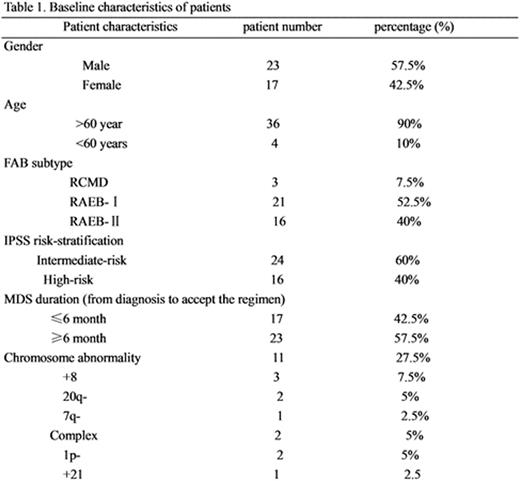Abstract
Background:
Myelodysplastic syndrome (MDS) represents a heterogenous group of meyloid clonal disorders typically characterized by aberrant myeloid differentiation, dysplasticchanges, ineffective hematopoiesis and high potential to progress into acute meyloid leukemia. In the general population, the incidence of MDS is approximately 5/100000 and the mean age of onset of MDS is 68 years. Most of the patients in middle-2 and high risk were uneligible for intensive therapy.
It have been confirmed that epigenetic play important roles in processes of tumorigenesis both in soild tumer and hematopoic malignacies. The aberrant changes of this key epigenetic process contribute significantly to the development of hematologic malignancies.Irregular DNA hypermethylation which lead to the silencing of tumor suppressor genes is a very commonamong MDS. The epigenetic therapy with hypomethylating agents has become a new strategy for the treatment ofpatients with MDS.The decitabine (DAC) is an inhibiter of DNA hypermethylationand act as an anti-tumor by reactivating the tumor suppressor genes. While the treatment dose and schedule of DAC haven't reach a consensus.
The CAG chemotherapy regimen is widely used for the treatment of patients with relapsed AML since 1995. The regimen is composed of low-dose cytosine arabinoside (10 mg/m2/12 h, usually day 1~14), low-dose aclarubicin (10-14 mg/m2/day, day 1~4), and concurrent use of G-CSF (200 micrograms/m2/day).But the cardiotoxicity limit its application among elder patients. So we tried to modify the regimen by replacing the aclarubicin with homoharringtonine (HHT) which was reported have the function of arresting leukemic cell cycle, inducing apoptosis and it has been used in the treatment of AML in China for decades.
The aim of this study was to provide a retrospective analysis of the safety and performance of ultra low-dose decitabine combined a modified protocol GHA to find an option for middle-2 and high risk MDS patients.
Methods:
Retrospective analysis of 40 MDS patients who were enrolled in the low-dose decitabine combined with GHA regimen. All the patients were classified in to RAEB1/2(Refractory anemia with excess blasts) or RCMD (Refractory cytopenia with multilineage dysplasia) by 2008 WHO classification of MDS. In IPSS (international prognostic scoring system), all the patients were categoried in intermediate-2 or high risk. The decitabine were used at the dose of 10 mg/d given intravenously over 1 h daily for 5 days (d1~5). The GHA regimen consisted of homoharringtonine 1mg/m2 daily by intravenous continuous infusion d 1~14), cytarabine 10mg/m212hr by subcutaneous injection (day 1~14), and G-CSF200 mg/m2/day by subcutaneousinjection one day prior to chemotherapy and continued until the end of chemotherapy or when the peripheral white blood cell (WBC) >20*109/L. The clinical efficiency and side effects were observed.
Results:
27 patients achieved CR and 5 patients achieved PR. The CR and PR rate were 67.5% and 12.5%, respectively. Total effective rate was 80%. In the induction therapy, a total of 10/40(25.0 %) patients experienced absolute neutrophol count (ANC) less than 0.5*109/L with a mean 8 days of agranulocytic period, and 28/40 (70%) patients experienced platelets less than 20*109/L with a mean 7 days of recovery over 20*109/L. The nonhematologic toxicities were mild and early death was zero. The median follow up time was 28 months; the median overall survival (OS) and disease free survival (DFS) were 25 and 12 months, respectively.
Conclusion:
The ultra low-dose decitabine combined with regimen is effective and well tolerated in induction therapy for intermediate-2 and high-risk MDS who were uneligible for intensive therapy and the results are better than the single regimen of decitabine or GHA.
No relevant conflicts of interest to declare.
Author notes
Asterisk with author names denotes non-ASH members.



This feature is available to Subscribers Only
Sign In or Create an Account Close Modal